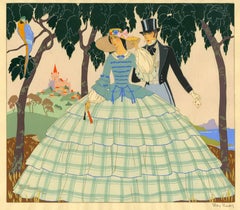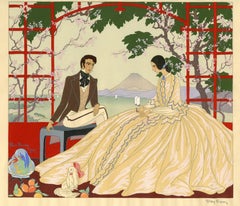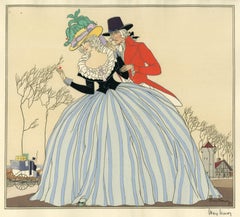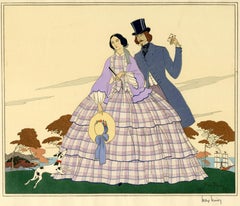Want more images or videos?
Request additional images or videos from the seller
1 of 4
Adolf DehnFranky and Johnny in Paris1928
1928
$4,000List Price
About the Item
- Creator:Adolf Dehn (1895 - 1968, American)
- Creation Year:1928
- Dimensions:Height: 8.875 in (22.55 cm)Width: 13.125 in (33.34 cm)
- Medium:
- Movement & Style:
- Period:
- Condition:Very fined condition, direct from the artist's estate.
- Gallery Location:Fairlawn, OH
- Reference Number:Seller: AD01071.231stDibs: LU1406040662
About the Seller
5.0
Recognized Seller
These prestigious sellers are industry leaders and represent the highest echelon for item quality and design.
Platinum Seller
Premium sellers with a 4.7+ rating and 24-hour response times
Established in 1978
1stDibs seller since 2013
814 sales on 1stDibs
Associations
International Fine Print Dealers Association
Authenticity Guarantee
In the unlikely event there’s an issue with an item’s authenticity, contact us within 1 year for a full refund. DetailsMoney-Back Guarantee
If your item is not as described, is damaged in transit, or does not arrive, contact us within 7 days for a full refund. Details24-Hour Cancellation
You have a 24-hour grace period in which to reconsider your purchase, with no questions asked.Vetted Professional Sellers
Our world-class sellers must adhere to strict standards for service and quality, maintaining the integrity of our listings.Price-Match Guarantee
If you find that a seller listed the same item for a lower price elsewhere, we’ll match it.Trusted Global Delivery
Our best-in-class carrier network provides specialized shipping options worldwide, including custom delivery.You May Also Like
HER NEW BLUE COAT Signed Lithograph, Art Deco Style Fashion Portrait, Tweed Suit
By Robin Morris
Located in Union City, NJ
HER NEW BLUE COAT by the woman artist Robin Morris, is an original limited edition lithograph printed using hand lithography techniques(not a photo reproduction or digital print) on ...
Category
1980s Art Deco Portrait Prints
Materials
Lithograph
GANGSTERS Signed Lithograph, City Portrait, Men, Buildings, Dark Sunglasses
By Robin Morris
Located in Union City, NJ
GANGSTERS by the woman artist Robin Morris, is an original limited edition lithograph printed in 15 colors using hand lithography techniques on archival Arches paper, 100% acid free....
Category
1980s Art Deco Portrait Prints
Materials
Lithograph
TRES AMIGOS Signed Lithograph, Musical Trio, Guitars, Saxophone Latin Music, Red
By Robin Morris
Located in Union City, NJ
TRES AMIGOS by the woman artist Robin Morris, is an original limited edition lithograph printed using hand lithography techniques(not a photo reproduction or digital print) on archiv...
Category
1980s Art Deco Portrait Prints
Materials
Lithograph
Deutsche Werkbund-Ausstellung (German Workers Union Exhibition Art)
By Peter Behrens
Located in London, GB
Peter Behrens, (German 1868-1940), Deutsche Werkbund-Ausstellung, 1914, Deutsche Werkbund-Ausstellung, Kunst in Handwerk, Industrie und Handel Archit...
Category
1910s Art Deco Figurative Prints
Materials
Paper, Lithograph
$8,581
H 37.41 in W 25.6 in D 0.79 in
P. ROQUE, poster for the International Exhibition of Decorative Arts
Located in Paris, FR
- Lithographic poster for the International Exhibition of Decorative Arts, 1925.
- Printed by Edmond Bernard, Paris.
Dimensions
H : 121,2 cm L : 80,4 cm/H: 47.72 in W: 31.65 in
Category
1920s Art Deco Figurative Prints
Materials
Lithograph
$5,993
H 47.72 in W 31.66 in
Cabaret Dancer (ala Toulouse Lautrec)
By Marcel Vertès
Located in Surfside, FL
This is an original hand signed (I believe it is also hand colored but i am not positive) Artists Proof Lithograph of a Circus scene. This depicts a Cabaret Dancer.
This came from a...
Category
1940s Art Deco Figurative Prints
Materials
Lithograph
Vintage Chinese Deco-Era Lithograph Print
Located in Chicago, IL
This advertising poster from the 1930s melds the meticulous detail of traditional Chinese painting with the craft of color lithography. These advertisements, influenced by the Art De...
Category
1920s Art Deco Figurative Prints
Materials
Paper, Lithograph
"La Princesse Lointaine", Erte, Original Serigraph numbered 291/300, Art Deco
By Erté
Located in Dallas, TX
"La Princesse Lointaine" is a serigraph created in 1984 by Erté. Classic art deco piece with a gaudy princess in yellow and pink with a star above ...
Category
1980s Art Deco Figurative Prints
Materials
Lithograph, Screen
Art Deco Antique Poster "Eugene - Ondulation Permanente"
Located in Hinsdale, IL
FOSSEY (DATES UNKNOWN)
EUGENE / ONDULATION PERMANENTE. 1926.
Shee Size: 35 1/4x22 1/2 inches, 89 1/2 x 57 cm. C. Courtois, Paris.
This is a gorgeous example of art deco artwork...
Category
1920s Art Deco Figurative Prints
Materials
Lithograph
$6,950
H 44.25 in W 31.25 in D 1.5 in
Original USA BONDS Weapons for Liberty WW1 Third Liberty Loan vintage poster
By Joseph Christian Leyendecker
Located in Spokane, WA
Original vintage World War I poster. U.S.A. bonds: Third Liberty Loan campaign: Boy Scouts of America. Depicted: Boy Scout handing a sword inscribed "Be prepared" to a stylized warri...
Category
1910s Art Deco Portrait Prints
Materials
Lithograph
$1,795
H 30 in W 20 in D 0.3 in
More From This Seller
View AllEn Espagne
By Victor Max Ninon
Located in Fairlawn, OH
En Espagne
Pochoir (silk screen) printed in colors
Signed by the artist in pencil lower right
The artist won a gold medal in Paris in 1925 for his pochoirs
Condition: Excellent
Image...
Category
1920s Art Deco Figurative Prints
Materials
Screen
Au Japon
By Victor Max Ninon
Located in Fairlawn, OH
Au Japon
Pochoir (Stencil Print), 1925
Signed by the artist in pencil lower right (see photo)
Signed in the image lower left (see photo)
Stamped verso: Made in France
Note: The artis...
Category
1920s Art Deco Figurative Prints
Materials
Screen
Robe Grise
By Victor Max Ninon
Located in Fairlawn, OH
Robe Grise
Pochoir (silk screen) printed in colors, 1923
Signed by the artist in pencil lower right (see photo)
The artist won a gold medal in Paris in 1925 for his pochoirs
Condition: Two spots in the upper left corner associated with the printing.
Victor Max Ninon (Vittorio Accornero de Testa, Italian, 1896-1982)
Biography
Vittorio Accornero de Testa was born in Casale Monferrato in 1896. He completed his first studies at the "Leardi" institute, but was forced to interrupt them due to the war events of the First World War . At 19 he was second lieutenant of the Alpine troops and in 1916 he took one of the first pilot's licenses. During the war he knows the bitterness of shooting down in air combat (for which he is decorated), but also the good fortune to stay alive, albeit with a disability. His art blossomed in the postwar period, first signing his works simply Ninon and then, probably at the suggestion of a French publisher, under the pseudonym of "Victor Max Ninon" (Victor and Max indicate strength and masculinity, Ninon boyhood) .In 1919 and 1924 he made illustrations for theGiornalino della Domenica , also together with his first wife Edina Altara , for Ardita and La Lettura . In 1923 he won the cover competition organized by the magazine El Hogar of Buenos Aires and in 1925 with his pochoirs he imposed himself in Paris at the international exhibition of modern decorative and industrial arts , obtaining a gold medal. In the same year he made two covers for the US magazine The Smart Set . In the 1920s he made numerous series of art deco style postcards for the Milanese publishing house Degami . On June 4, 1929, aGenoa embarks on the Conte Grande together with his wife Edina Altara , for New York . The two stayed in the American metropolis for a few months: in this period Accornero worked on the creation of theatrical sets and created some covers for Country Life magazine . Accornero gets awards and prizes, but the great economic crisis of the time and the nostalgia for Italy convince the two to return to their homeland, where they resume their activity as illustrators.
In 1934 Accornero moved to Milan, separated amicably from his wife and continued to dedicate himself to the illustration of children's books, abandoning the pseudonym Victor Max Ninon. It illustrates about 60 books, from the fables of Andersen , Perrault and Grimm , to the tales of Poe , as well as the famous Pinocchio and Cuore published by Mondadori, Mursia, Hoepli, Martello. Several books illustrated by Accornero have been published in French, Spanish, German and English. In addition to the periodicals already mentioned, he collaborates on the first edition of the Encyclopedia of Boys , Mondadori, and with the Italian magazines Lidel , Il Secolo XX, The Italian Illustration , Fantasies of Italy , The Woman , Cordelia , For You Lady , Grace , Metropolis , La Domenica del Corriere , The Corriere dei Piccoli .
In 1936 enters the world of cinema, creating sets and costumes for Wedding Vagabonde of Guido Brignone and The White Squadron of Augustus Genina . From 1935 to 1950 he also devoted himself to the theater, taking care of sets and costumes for numerous operettas, ballets and performances at the Scala in Milan and for the Milanese theaters Manzoni, Lirico and Olympia. Stages Marcello di Giordano, Nina pazza d'amore by Paisiello, I cantori di Nurimberga by Wagner, La Bohème by Puccini and other works. For this activity he is also cited in the Theater encyclopedia.
In the 1940s and 1950s he wrote and illustrated six books for children for Mondadori: Tomaso (1944), Giacomino (1949), Tomaso Cacciatore (1950), Zio Stefano (1950), In Campagna che delizia! (1953), Tomaso, dear Tomaso (1955). His illustrations of Perrault's Tales published in those years by Hoepli are famous.
His art in the fifties evolves towards hyperrealism . There are many personal exhibitions in Italy and abroad, including those at the Gallerie Gussoni (1959) and Bolzani (1963 and 1966) in Milan and Walcheturm (1962) in Zurich. Eminent critics praise his work, from Orio Vergani to Enrico Piceni, from Reto Roedel to De Chirico himself. On the Domenica del Corriere , the journalist, writer and painter Dino...
Category
1920s Art Deco Figurative Prints
Materials
Stencil
Coquette
By Victor Max Ninon
Located in Fairlawn, OH
Coquette
Pochoir (silk screen) printed in colors, c. 1923-1925
Signed by the artist in pencil lower right; numbered in ink on the image, (see photo)
Edition: 250 (100/250) in pencil in image (see photo)
Image size: 10-1/2 x 12-3/4"
The artist won a gold medal in Paris in 1925 for his porchoirs
Victor Max Ninon (Vittorio Accornero de Testa, Italian, 1896-1982)
Biography
Vittorio Accornero de Testa was born in Casale Monferrato in 1896. He completed his first studies at the "Leardi" institute, but was forced to interrupt them due to the war events of the First World War . At 19 he was second lieutenant of the Alpine troops and in 1916 he took one of the first pilot's licenses. During the war he knows the bitterness of shooting down in air combat (for which he is decorated), but also the good fortune to stay alive, albeit with a disability. His art blossomed in the postwar period, first signing his works simply Ninon and then, probably at the suggestion of a French publisher, under the pseudonym of "Victor Max Ninon" (Victor and Max indicate strength and masculinity, Ninon boyhood) .In 1919 and 1924 he made illustrations for theGiornalino della Domenica , also together with his first wife Edina Altara , for Ardita and La Lettura . In 1923 he won the cover competition organized by the magazine El Hogar of Buenos Aires and in 1925 with his pochoirs he imposed himself in Paris at the international exhibition of modern decorative and industrial arts , obtaining a gold medal. In the same year he made two covers for the US magazine The Smart Set . In the 1920s he made numerous series of art deco style postcards for the Milanese publishing house Degami . On June 4, 1929, aGenoa embarks on the Conte Grande together with his wife Edina Altara , for New York . The two stayed in the American metropolis for a few months: in this period Accornero worked on the creation of theatrical sets and created some covers for Country Life magazine . Accornero gets awards and prizes, but the great economic crisis of the time and the nostalgia for Italy convince the two to return to their homeland, where they resume their activity as illustrators.
In 1934 Accornero moved to Milan, separated amicably from his wife and continued to dedicate himself to the illustration of children's books, abandoning the pseudonym Victor Max Ninon. It illustrates about 60 books, from the fables of Andersen , Perrault and Grimm , to the tales of Poe , as well as the famous Pinocchio and Cuore published by Mondadori, Mursia, Hoepli, Martello. Several books illustrated by Accornero have been published in French, Spanish, German and English. In addition to the periodicals already mentioned, he collaborates on the first edition of the Encyclopedia of Boys , Mondadori, and with the Italian magazines Lidel , Il Secolo XX, The Italian Illustration , Fantasies of Italy , The Woman , Cordelia , For You Lady , Grace , Metropolis , La Domenica del Corriere , The Corriere dei Piccoli .
In 1936 enters the world of cinema, creating sets and costumes for Wedding Vagabonde of Guido Brignone and The White Squadron of Augustus Genina . From 1935 to 1950 he also devoted himself to the theater, taking care of sets and costumes for numerous operettas, ballets and performances at the Scala in Milan and for the Milanese theaters Manzoni, Lirico and Olympia. Stages Marcello di Giordano, Nina pazza d'amore by Paisiello, I cantori di Nurimberga by Wagner, La Bohème by Puccini and other works. For this activity he is also cited in the Theater encyclopedia.
In the 1940s and 1950s he wrote and illustrated six books for children for Mondadori: Tomaso (1944), Giacomino (1949), Tomaso Cacciatore (1950), Zio Stefano (1950), In Campagna che delizia! (1953), Tomaso, dear Tomaso (1955). His illustrations of Perrault's Tales published in those years by Hoepli are famous.
His art in the fifties evolves towards hyperrealism . There are many personal exhibitions in Italy and abroad, including those at the Gallerie Gussoni (1959) and Bolzani (1963 and 1966) in Milan and Walcheturm (1962) in Zurich. Eminent critics praise his work, from Orio Vergani to Enrico Piceni, from Reto Roedel to De Chirico himself. On the Domenica del Corriere , the journalist, writer and painter Dino Buzzati...
Category
1920s Art Deco Figurative Prints
Materials
Stencil
Circle of Life
By Rudolf Bauer
Located in Fairlawn, OH
Circle of Life
Lithograph on tan paper, c. 1910's
Signed in pencil lower right; signed in the plate lower right
(see photo)
Annotated "No. 50" in pencil lower left (see photo)
...
Category
1910s Expressionist Figurative Prints
Materials
Lithograph
Les Pelerins d'Emmaus (The Pilgrims of Emmaus)
By Maurice Denis
Located in Fairlawn, OH
Les Pelerins d'Emmaus (The Pilgrims of Emmaus)
After a 1894 painting by Denis in the Van Gogh Museum (see photo)
Color lithograph, 1895
Signed in pencil ...
Category
1890s French School Figurative Prints
Materials
Lithograph
Recently Viewed
View AllMore Ways To Browse
Muro Print
Mystery Of Sleep Dali
Nadia Comaneci
Nature Woodblock
Norman Hirst
Norman Rockwell Clock
Norman Rockwell Tom Sawyer
Nude Flask
Nude With Garter Dali
Odilon Redon On Sale
Oli Epp
Original Etching Roman Emperor
Ota Masamitsu
Oyvind Fahlstrom On Sale
Pablo Picasso Signed Aquatint
Pablo Picasso The Kiss
Parc Monceau Harold Altman
Pegge Hopper Print



